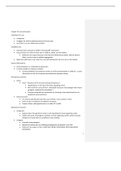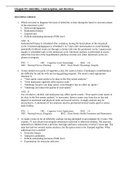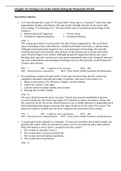Nurs 4403 Study guides, Class notes & Summaries
Looking for the best study guides, study notes and summaries about Nurs 4403? On this page you'll find 35 study documents about Nurs 4403.
Page 2 out of 35 results
Sort by
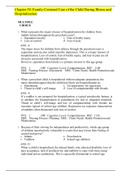
-
Chapter 38: Family-Centered Care of the Child During Illness and Hospitalization,100% CORRECT
- Exam (elaborations) • 19 pages • 2021
-
- $15.49
- + learn more
Chapter 38: Family-Centered Care of the Child During Illness and Hospitalization MULTIPLE CHOICE 1. What represents the major stressor of hospitalization for children from middle infancy throughout the preschool years? a. Separation anxiety c. Fear of bodily injury b. Loss of control d. Fear of pain 2. When a preschool child is hospitalized without adequate preparation, the nurse should recognize that the child may likely see hospitalization as: a. Punishment. c. An opportunity for...
NURS 4403 - Exam 1 Study Guide. CONCEPTION, ANTEPARTUM, INTRAPARTUM 1. Reva Rubin’s 4 major tasks Ensuring safe passage through pregnancy and birth.
NURSING 4403_Chapter 19: Nursing Care of the Family during the Postpartum Period_Correct Answers and Questions.
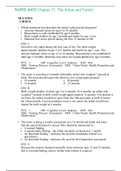
-
NURS 4403 Chapter 31: The Infant and Family,100% CORRECT
- Exam (elaborations) • 35 pages • 2021
-
- $17.49
- + learn more
NURS 4403 Chapter 31: The Infant and Family MULTIPLE CHOICE 1. Which statement best describes the infant’s physical development? a. Anterior fontanel closes by age 6 to 10 months. b. Binocularity is well established by age 8 months. c. Birth weight doubles by age 5 months and triples by age 1 year. d. Maternal iron stores persist during the first 12 months of life. 2. The nurse is assessing a 6-month-old healthy infant who weighed 7 pounds at birth. The nurse should expect the i...
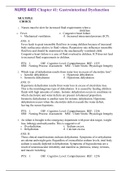
-
NURS 4403 Chapter 41: Gastrointestinal Dysfunction,100% CORRECT
- Exam (elaborations) • 33 pages • 2021
-
- $16.49
- + learn more
NURS 4403 Chapter 41: Gastrointestinal Dysfunction MULTIPLE CHOICE 1. Nurses must be alert for increased fluid requirements when a child has: a. Fever. c. Congestive heart failure. b. Mechanical ventilation. d. Increased intracranial pressure (ICP). 2. Which type of dehydration results from water loss in excess of electrolyte loss? a. Isotonic dehydration c. Hypotonic dehydration b. Isosmotic dehydration d. Hypertonic dehydration 3. An infant is brought to the emergency departm...
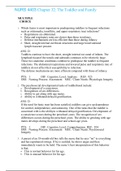
-
NURS 4403 Chapter 32: The Toddler and Family,100% CORRECT
- Exam (elaborations) • 27 pages • 2021
-
- $16.49
- + learn more
NURS 4403 Chapter 32: The Toddler and Family MULTIPLE CHOICE 1. Which factor is most important in predisposing toddlers to frequent infections such as otitis media, tonsillitis, and upper respiratory tract infections? a. Respirations are abdominal. b. Pulse and respiratory rates are slower than those in infancy. c. Defense mechanisms are less efficient than those during infancy. d. Short, straight internal ear/throat structures and large tonsil/adenoid lymph tissue are present. 2....
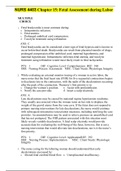
-
NURS 4403 Chapter 15: Fetal Assessment during Labor,100% CORRECT
- Exam (elaborations) • 29 pages • 2021
-
- $16.79
- + learn more
NURS 4403 Chapter 15: Fetal Assessment during Labor MULTIPLE CHOICE 1. Fetal bradycardia is most common during: a. Intraamniotic infection. b. Fetal anemia. c. Prolonged umbilical cord compression. d. Tocolytic treatment using terbutaline. 2. While evaluating an external monitor tracing of a woman in active labor, the nurse notes that the fetal heart rate (FHR) for five sequential contractions begins to decelerate late in the contraction, with the nadir of the decelerations occurr...
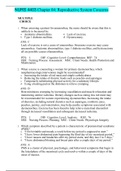
-
NURS 4403 Chapter 04: Reproductive System Concerns,100% CORRECT
- Exam (elaborations) • 33 pages • 2021
-
- $17.49
- + learn more
NURS 4403 Chapter 04: Reproductive System Concerns MULTIPLE CHOICE 1. When assessing a patient for amenorrhea, the nurse should be aware that this is unlikely to be caused by: a. Anatomic abnormalities. c. Lack of exercise. b. Type 1 diabetes mellitus. d. Hysterectomy. 2. When a nurse is counseling a woman for primary dysmenorrhea, which nonpharmacologic intervention might be recommended? a. Increasing the intake of red meat and simple carbohydrates b. Reducing the intake of diure...
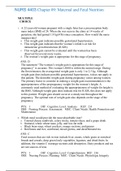
-
NURS 4403 Chapter 09: Maternal and Fetal Nutrition,100% CORRECT
- Exam (elaborations) • 27 pages • 2021
-
- $16.49
- + learn more
NURS 4403 Chapter 09: Maternal and Fetal Nutrition MULTIPLE CHOICE 1. A 22-year-old woman pregnant with a single fetus has a preconception body mass index (BMI) of 24. When she was seen in the clinic at 14 weeks of gestation, she had gained 1.8 kg (4 lb) since conception. How would the nurse interpret this? a. This weight gain indicates possible gestational hypertension. b. This weight gain indicates that the woman’s infant is at risk for intrauterine growth restriction (IUGR). c. T...

